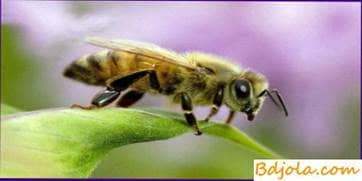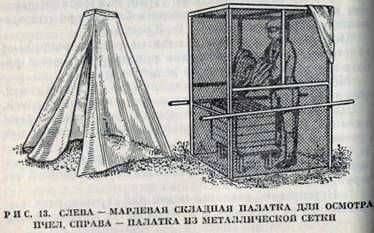 In a time-free period, especially with a sudden cessation of honey collection, old bees, worried about the need to replenish fodder reserves, wind around the storehouse where they store food for them, and at the tapping of foreign hives, trying to penetrate them.
In a time-free period, especially with a sudden cessation of honey collection, old bees, worried about the need to replenish fodder reserves, wind around the storehouse where they store food for them, and at the tapping of foreign hives, trying to penetrate them.
Watch bees of strong families protect honey reserves well and do not allow thieves to get closer to the tap. Victims of bees-thieves become bezmatochnye, weak and sick families. If you do not take timely measures, then bee-thieves, robbing bezmatamochnye and weak families, can attack and strong.
In most cases, bee larceny arises from the inaccuracy of the beekeeper during the feeding of the bees and the untimely inspection of the bee nests, as a result of which a conditioned reflex to the theft of honey is developed. It is only necessary to open the hive, as bees-thieves attacked the frames and penetrated the hive to steal honey. On the combs and at the tap, a fight begins, and dead bees appear. The master bees become evil. Termination of work, reduction or temporary intermittent closing and opening of the tap can stop theft, but bee-thieves do not calm down. In the apiary they fly their scouts on duty.
It is only necessary to take a smoke and go to the hive, as beekeepers are bees-thieves. It is impossible to open a hive in these conditions. Otherwise, bees who have stolen honey in an open hive, mobilize other bees for such an easy prey, and bee-owners can not always be protected from the persistent attack of bee-thieves. The fight of bees near the defeat of the defeated family soon ceases, and for the active years of bee-robbers inexperienced beekeeper can accept for the good work of the family. Therefore, the beekeeper must know that the years of bees from the stolen family can be in the cool and cloudy weather. It begins early in the morning and ends late at night, when the bees of other families do not fly.
From the robbed family, bee-thieves go hastily, many of them crawl up the front wall of the hive and, rising into the air, under the weight of the burden sometimes fall to the ground. If you squeeze the abdomen of the bee leaving the hive, a drop of honey will appear on the proboscis.
Bees stealing family, taking the last honey, fly to neighboring beehives, fly off or join the family-thief. Often when stealing honey from an unprotected hive, neighboring families, attracted by the smell of honey, are also included in the robbery. Thus, bee larceny passes into its highest form – into an attack, as a result of which many bee colonies will be destroyed and plundered. The attack of even a good honey crop can not always stop robbery. To save an apiary from distress can only prolonged prolonged rain or cold snap and, if possible, the isolation of bees-thieves, that is, the creation of a “home arrest” for them.
To prevent theft, a number of rules should be observed:
1. If possible, the exhibition of bees should be held simultaneously with the nearest apiaries. However, for a number of reasons, in particular because of the poor wintering of bees, some families are exhibited earlier than usual. In this case, in previously exhibited families on the day of the exhibition, the main bees are closed. It is advisable to close them the next day.
2. Do not keep beekeeping and bezmatychnye and weak families.
3. Reduce the tapewings and nests of bees according to their strength and have enough fodder reserves.
4. In a nondescript time, inspect the nests only when absolutely necessary in the morning, in the afternoon or in the evening. The work should be carried out quickly with the simultaneous opening of no more than 2-3 frames.
Observed in the nest and seized frames are covered with a canvas. In case of signs of theft, the work is stopped and transferred to another time.
You can see a large number of bee colonies, if for the time of work to close the gates of the families inspected.
To seal the working time, the bees are examined in a special portable tent, covered with gauze or wire mesh.

5. Feeding of bees, especially by substituting honey frames, is carried out at a non-flying time for bees, preferably by evening.
6. It is unacceptable to smear honey or hive syrup, throwing litter out of the hive, in which there may be grains of candied honey, attracting bees-thieves.
7. When taking out a reserve apiary for a nomadic movement, you should not place it on a flight, that is, in front or behind another apiary, located in a straight line to the honey-crop. In this case, bees flying through the apiary in unfavorable weather can remain on the apiary along the way, and with a sharp cessation of the honey crop – plunder it.
Increased vorovity is characteristic of bees of southern breeds, especially Italian, Caucasian and their subterranean ranges. Even with a small supporting honey, they are traded in dysfunctional families. There is a case where a hothouse family with Italian bees looted a deceased family at an open point at a distance of 0.5 km.
If there is a doubt that the family is being robbed, it is necessary to close the tray for a few minutes. Then the chute is opened, and the bees that fly out of the hive are sprinkled with flour. They look at the direction of their flight and on the returning labeled bees establish a family-thief.
In order to distract bees from theft, it is necessary to create an unusual environment for them, delaying their flight into the embezzled family. This is achieved by turning the hive of the family-thief in a different direction. Once the bees have mastered the new direction of the tap, the hive turns again.
For the occupation of bees by work, in order to distract them from theft, they fill the sawdust on top of the frame and extend the tray. Bees will be forced to switch to cleaning and guarding the nest.
Good results are when exchanging the hives of stolen and attacking families. However, this is unacceptable in apiaries, where there are different breed bee colonies. They destroy the bees that flew to them from other families. If the above measures do not work, the family member is transferred to another location. Instead, they put a beehive with empty honeycombs. All flying bees will return to the old place, in the hive where there is no uterus or brood. The stressful condition cools their rush, and theft quickly ceases. In the evening, the bees gathered should be given a frame with a different age brood and replenish the forage reserves. If this is not done, then the bees fly to neighboring families.
In the bee family that has just been robbed, it is easy to reduce the size of the simultaneous passage of no more than 1-2 bees or temporarily close completely.
In case of more severe theft, a piece of clay is placed on the hive of the hive of the embezzled family and several holes are pierced with a rod in it. Their bees pass through the holes, but the thieves avoid. Some beekeepers put rags soaked in kerosene or other substance with repulsive odor in film or in waterproof paper on the scoop, for example, in carbolic acid, but the beehive should not be stained with these substances.
In the case of attack, bees from another unknown apiary to bees in honeycombs or in feeders are given water. In the evening, the hives are taken to a cool room (winter hut). In place of stolen families put an empty hive, which put rags, moistened with deterrent. If it is not possible to remove the injured families, the bees are given water and the nest ventilation is organized (see Protection of bees from poisoning). Hives are covered with film or tarpaulin, giving them an unpleasant smell. At night and other non-flying time, tapholes in the hives are opened. As soon as bees-thieves cease to fly to the place of stolen families, the hives are taken out of the winter hut and put in their original place. In this case, they open the tapes by 0.5-1 cm.
There are cases when bee families are robbed in the presence of good honey collection, without the resistance of master bees. Moreover, there is mutual robbery with a large accumulation of honey in a stronger family, the so-called secretive theft. It happens in two cases. The first case – with a sudden breakage of the honey and a good weather. Bee-thieves attract the smell of honey, and they freely enter the hive. The second case – with the same smell in the hives.
In the case of honey theft, in this case the beekeeper is guilty. Applying clumsy chemical drugs against varroatosis, the “family” odor is interrupted in bee families, a smell is formed for many families, and bee-watchmen do not recognize alien bees. To facilitate the recognition of the stealing bees from their own, several mashed stems of peppermint or other smelling plants are placed at the bottom of the hive for the night, and the beehives are cut in the hives.
From what has been said, it can be seen that bee theft is a very dangerous phenomenon in the apiary, it is easier to prevent it than to fight it.
Сроки медосбора. Подсадка матки в клеточке.
Hothouse beekeeping